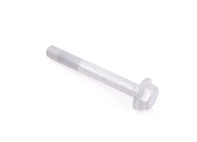Engine Mounts
 Hex head bolt M10x80 for engine mount. Porsche 986 Boxster / 987.1 Boxster / 987.1 Cayman
Hex head bolt M10x80 for engine mount. Porsche 986 Boxster / 987.1 Boxster / 987.1 Cayman

- Porsche Boxster 986 2.5L 1997-99
- Porsche Boxster 986 2.7L 1999-02
- Porsche Boxster S 986 3.2L 1999-02
- Porsche Boxster 986 2.7L 2003-04
- Porsche Boxster S 986 3.2L 2003-04
- Porsche Boxster 987 2.7L 2005 -08/08
- Porsche Boxster 987 S 3.2/3.4L 2005-08/08
- Porsche Cayman 2.7L 987C 2006-08
- Porsche Cayman S 3.4L 987C 2005-08

Fits:
Porsche 986 Boxster - 1997 to 2004
Porsche 987.1 Boxster - 2005 to 2008
Porsche 987.1 Cayman - 2005 to 2008
Click 'Zoom in' for large parts diagram.
Diagram ref no 10
Related reference numbers
Related, superseded, cross reference or alternative numbers for comparison.
99907205501
The product you are viewing cross references to these numbers
 Shop Securely
Shop Securely
 12 Month Warranty
12 Month Warranty
 Worldwide Delivery
Worldwide Delivery
 Hydraulic mount (non dynamic) for gearbox. Porsche 981 Boxster / 981C Cayman / Cayman GT4
Hydraulic mount (non dynamic) for gearbox. Porsche 981 Boxster / 981C Cayman / Cayman GT4

- Porsche Boxster 981 2.7L 2012-16
- Porsche Boxster S 981 3.4L 2012-16
- Porsche Cayman 2.7L 981 2013-16
- Porsche Cayman S 3.4L 981 2013-16
- Porsche Cayman GT4 3.8L 2015-16

Fits:
for cars WITHOUT Dynamic engine mount (PADM)
Porsche 981 Boxster 2012-16
Porsche 981C Cayman 2014-16
Porsche 981 Cayman GT4 2016
Click 'Zoom in' for large parts diagram.
Diagram ref no 3
Related reference numbers
Related, superseded, cross reference or alternative numbers for comparison.
98137504902
The product you are viewing cross references to these numbers
 Shop Securely
Shop Securely
 12 Month Warranty
12 Month Warranty
 Worldwide Delivery
Worldwide Delivery
Engine mounts, also called motor mounts, are critical components of your Porsche, securing the engine to the chassis and absorbing vibrations during operation. Traditionally, rubber has been the go-to material for these mounts, but polyurethane is gaining popularity due to its enhanced performance and durability compared to rubber.
Polyurethane motor mounts excel at absorbing vibrations, ensuring a smoother and quieter ride, benefiting both driver and passengers. Although they are initially more expensive than rubber mounts, their longer lifespan makes them more cost-effective over time, reducing maintenance and replacement expenses.
In high-performance vehicles like Porsches, motor mounts face extreme stress, vibrations, heat, and pressure. Uprated polyurethane motor mounts provide additional benefits by limiting engine movement, enhancing engine stability during acceleration and gear shifts, and offering improved gear engagement, thus protecting gearboxes and shafts.








